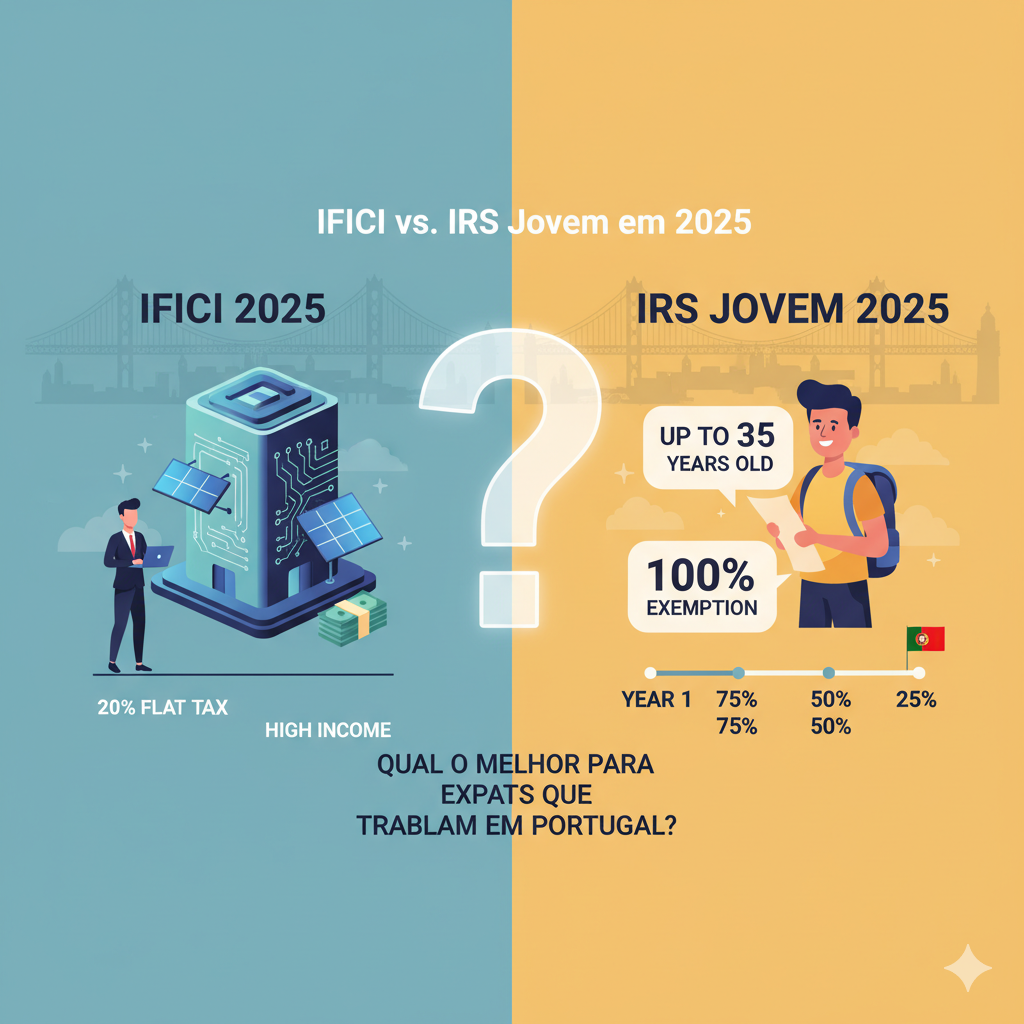If you’re international talent thinking of settling in Portugal—or a Portuguese person returning from abroad—it’s natural to ask: should I take advantage of the Youth IRS (IRS Jovem) or register for the IFICI (Tax Incentive for Scientific Research and Innovation)?
Below, we explain, with updated 2025 rules, when each regime is more beneficial and show illustrative calculations.
What Changed and Who Can Use It
Youth IRS (IRS Jovem) (2025)
| Category | Details |
| Target Audience | Young people up to 35 years old (as of 12/31), with employment income (Category A) and/or self-employment income (Category B), who are not dependents within a household. |
| Benefit | Partial IRS exemption for up to 10 years (counted from the 1st year of earning Category A/B income as non-dependent), with an annual limit of 55 IAS (in 2025, €28,737.50). |
| Exemption Scaling | 100% in the 1st year; 75% in the 2nd, 3rd, and 4th years; 50% in the 5th, 6th, and 7th years; 25% in the 8th, 9th, and 10th years. |
| Non-Cumulative With | Non-Habitual Resident (NHR) regime, IFICI, and the tax regime for former residents (Regressar Program). Applied by annual option in the IRS declaration. |
| Withholding Tax (Category A) | You can request a monthly reduction of the withholding from the employer based on the exempted portion. The AT (Tax Authority) clarified the calculation method in the 2025 tables. For the self-employed (Category B), the reduction does not apply to withholding—the benefit is calculated in the annual adjustment. |
| Note | The 55 IAS limit uses the 2025 IAS = €522.50 (Portaria 6-B/2025), totaling €28,737.50 of potentially exempt base. |
Exportar para Sheets
IFICI (Art. 58-A of the EBF)
| Category | Details |
| Target Audience | Professionals in scientific activities, innovation, and qualified jobs (list of eligible professions/CAEs), including Category A/B income, when included in recognized entities/conditions (FCT, AICEP, IAPMEI, ANI, Startup Portugal, among others). |
| Benefit | Single special rate of 20% on eligible Category A/B income, for up to 10 years. |
| Registration | Applications via the Tax Portal (Portal das Finanças), with validation by the competent entity; rules and deadlines are in Portaria no. 352/2024/1 (amended by Portaria no. 52-A/2025). |
Exportar para Sheets
Can I combine Youth IRS with IFICI?
No. The law makes these regimes mutually exclusive: if you benefit (or have benefited) from NHR, IFICI, or the former resident regime, you cannot use the Youth IRS in that year(s). The choice must be made based on your profile and time horizon.
When is each regime more beneficial?
Rule of Thumb (2025):
- Are you ≤35 years old and in your first years of career? The Youth IRS is usually more advantageous—especially in the 1st year (100% exemption up to €28,737.50) and in years 2–4 (75%).
- Do you have high income and/or work in an eligible profession within a qualified entity? IFICI (20%) tends to surpass the Youth IRS from the middle/final years of the regime’s duration (when the exemption drops to 50%/25% and the 55 IAS ceiling limits the gain).
Quick Simulations (Purely Illustrative)
Simplified hypotheses, without personal deductions, just to compare the design of the regimes. Your actual case may differ.
| Scenario | Youth IRS (IRS Jovem) | IFICI (20%) | Tendency |
| Annual Salary €40,000, 28 years old, 1st eligible year | 100% exempt up to €28,737.50 ⇒ Taxable ≈ €11,262.50. Applying general rates, the tax due on this base is typically much lower than on a full salary. | 20% of €40,000 = €8,000. | Youth IRS wins, by a wide margin in the 1st year. |
| Annual Salary €80,000, 32 years old, 5th eligible year (50%) | 50% exempt up to €28,737.50 ⇒ Taxable ≈ €51,262.50. | 20% of €80,000 = €16,000. | Advantage begins to lean towards IFICI, especially with salaries above the Youth IRS ceiling and starting from years 5–7. |
| Annual Salary €120,000, 34 years old, 8th eligible year (25%) | 25% exempt up to €28,737.50 ⇒ Taxable ≈ €91,262.50. | 20% of €120,000 = €24,000. | IFICI clearly more favorable at this level. |
Exportar para Sheets
Practical Steps
To opt for Youth IRS
- At the company (Category A): Request, if desired, the reduction of withholding based on the Youth IRS (submit a declaration to the employer). Otherwise, it is applied in the annual liquidation.
- Self-employed (Category B): There is no reduction in withholding; the benefit is calculated in the annual declaration.
- In the IRS declaration: Exercise the option every eligible year.
To register for IFICI
- Confirm if your activity/entity is eligible (qualified professions, CAE/export conditions/investment support, R&D centers, startups, etc.).
- Submit the application on the Tax Portal (Portal das Finanças) (with supporting documentation). Verification involves the AT and/or entities like FCT, AICEP, IAPMEI, ANI, as applicable.
Conclusion: Which one to choose?
- If you are up to 35 years old and starting your career, Youth IRS usually maximizes savings in the first few years.
- If you work in an eligible IFICI activity and earn income above the Youth IRS ceiling, the 20% fixed rate tends to compensate more in the medium term.
Since the regimes are not cumulative, the decision must weigh age, salary, years of eligibility already “used,” and the entity’s framework.

